This article needs additional citations for verification .(September 2020) |


Friedrich Salzer (1 June 1827, Heilbronn - 14 May 1876, Heilbronn) was a German landscape painter. He specialized in winter scenes and forest views.
This article needs additional citations for verification .(September 2020) |


Friedrich Salzer (1 June 1827, Heilbronn - 14 May 1876, Heilbronn) was a German landscape painter. He specialized in winter scenes and forest views.
His father, Johann Jakob Salzer (1798–1879) came from Dettingen an der Erms to open a paint store, which eventually became a paint factory. He was born to his father's first wife, Elisabeth. After becoming a widower in 1860, his father married again, to the much younger Caroline Haas, who gave birth to his half-brother, Eugen , a publisher of evangelical literature.
He initially worked in his father's paint factory, while taking lessons from a local artist named Karl Baumann. In 1846, upon Baumann's recommendation, he moved to Munich to continue his artistic training and began his studies with the Tyrolean painter, Joseph Anton Rhomberg, who had been a Professor in Munich since 1827. His circle of friends there included Carl Ebert, Richard Zimmermann, who influenced his style, and Alexander von Kotzebue, a battle painter for whom he provided some landscape backgrounds. [1]
In 1863, he returned to Heilbronn and married Emilie von Lobstein, with whom he had four sons. After his father's retirement, he took over management of the paint factory. That, coupled with increasingly poor health, left him little time for painting during the last decade of his life.

Johann Heinrich Bleuler, the Elder was a Swiss artist who worked with porcelain, landscape sketches and gouache. He was also an art teacher and a publisher of engravings.
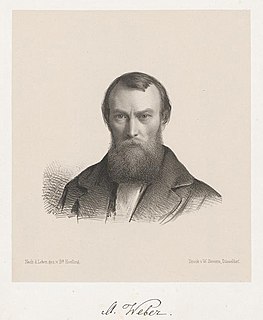
Johann Baptist Wilhelm August Weber was a German painter; associated with the Düsseldorfer Malerschule.

Carl Christian Vogel von Vogelstein, born Vogel, was a German painter.

Bernhard Studer was a Swiss landscape painter.

Adolph Friedrich Vollmer was a German landscape and marine painter and graphic artist. He and his contemporary, the painter Christian Morgenstern, were pioneers in Hamburg of early Realism in painting.

Christian Ernst Bernhard Morgenstern was a German landscape painter. Morgenstern is regarded as one of the pioneers in Germany of early Realism in painting. He gained this reputation in Hamburg 1826-1829 together with his contemporary Adolph Friedrich Vollmer while both were still studying; from 1830 onwards, Morgenstern, together with Friedrich Wasmann, Johan Christian Dahl and Adolph Menzel, introduced Munich to Realist painting.
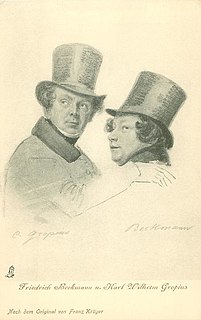
Karl Wilhelm Gropius, also Carl Wilhelm Gropius, was a German set painter and scenic artist, working in the theatres of Berlin. He was also a printmaker and seller and a prolific caricaturist.

Hermann Baisch was a German painter and illustrator who specialized in landscapes and animals. He was one of the first artists in Germany to work in the French influenced "paysage intime" style.
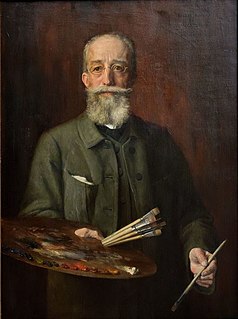
Julius Victor Carstens was a German painter. He worked in a variety of genres; including portraits, landscapes and still-lifes. He also painted a few church interiors.

Ludwig Willroider was an Austrian landscape painter and etcher.

Friedrich Horschelt was a German portrait painter.

Johann Heinrich Suhrlandt was a court painter for Duke Frederick II, and Grand Duke Frederick Francis I, of Mecklenburg-Schwerin.
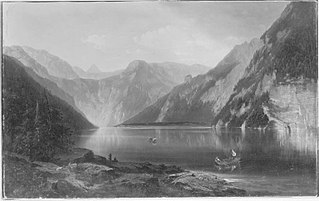
Carl Waagen was a German painter and lithographer.
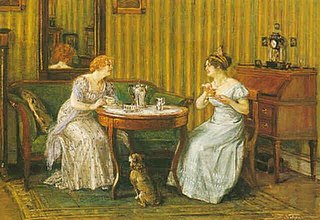
Karl August Friedrich Neuhaus, known as Fritz was a German genre and history painter; associated with the Düsseldorfer Malerschule.
Robert Friedrich Karl Scholtz was a German expressionist portrait and landscape painter, graphic artist and draughtsman. He belonged to the Berlin Secession mouvement.

Carl Gehrts, also Karl Gehrts, complete name Karl Heinrich Julius Gehrts was a German painter, illustrator and academic scholar. As a Professor, he taught at the Kunstakademie Düsseldorf.
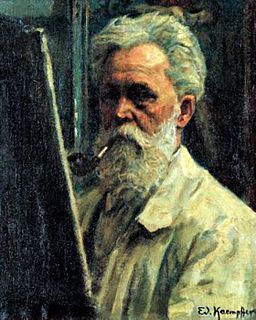
Eduard Kaempffer was a German painter, sculptor and medallist.
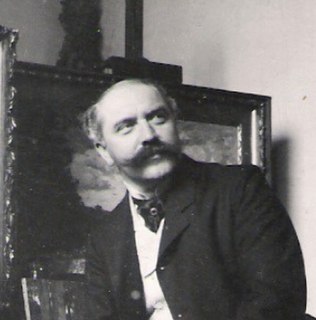
Wilhelm Feldmann was a German landscape painter, etcher, and lithographer.

Jules Wengel, born Julius Wilhelm Ludwig Wengel was a French painter and illustrator, of German origin. He painted in a variety of genres, including portraits, landscapes and religious works. Many of his paintings are watercolors.
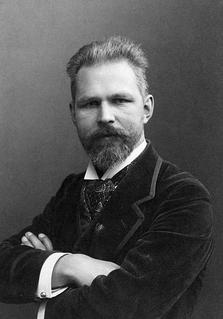
August Ludwig Georg Meyn was a German portrait and genre painter.
![]() Media related to Friedrich Salzer at Wikimedia Commons
Media related to Friedrich Salzer at Wikimedia Commons